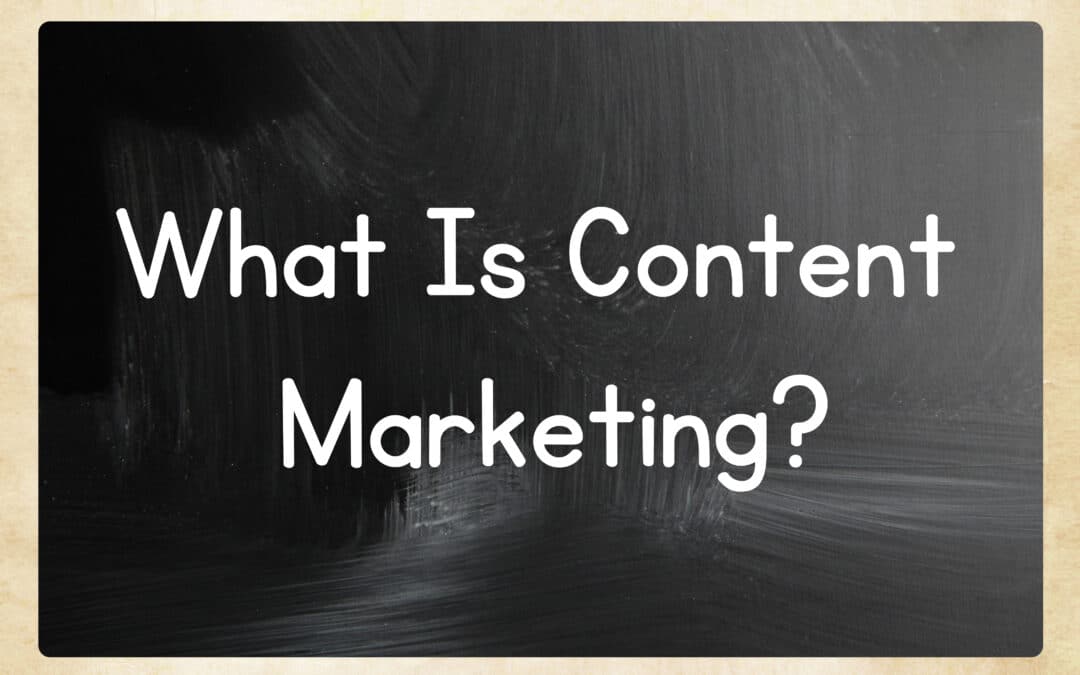Content marketing is immensely effective for a business’s bottom line. As such, it makes sense to invest heavily into a content marketing strategy — and that’s exactly what businesses are doing. According to HubSpot, 82% of marketers actively use content marketing and over 70% are actively investing in it. Content marketing is obviously a successful and useful strategy for any business, big or small — but what exactly is it? In this blog post we discuss what content marketing is, the differences between it and traditional marketing, why it’s important for your business, the various types of content marketing and how to develop a content marketing strategy of your own.
What Is Content Marketing?
The first step to understanding what content marketing really is, is to understand what it is not. The best way to do this is by comparing it to the traditional model of marketing. HubSpot tells us that, “Traditional marketing refers to any type of marketing that isn’t online. This means print, broadcast, direct mail, phone, and outdoor advertising like billboards. From newspapers to radio, this method of marketing helps reach targeted audiences.”
Traditional marketing does have its place. It is a tried-and-true method of reaching a target audience that has been used for decades — because it works! However, the main drawback of traditional marketing is that instead of drawing in the customer and engaging with them, businesses are broadcasting to their audience. There is no way to have a back and forth with the consumer about their product or service or to answer any questions they may have, something consumers clearly expect and desire in this day and age. This is where content marketing comes in.
According to HubSpot, “Content marketing is the process of planning, creating, distributing, sharing, and publishing content via channels such as social media, blogs, websites, podcasts, apps, press releases, print publications, and more. The goal is to reach your target audience and increase brand awareness, sales, engagement, and loyalty.” It is quite a bit more than simply pitching to your audience. The focus is on providing something of value to your customers and engaging with them as much as possible.
Why Is Content Marketing Important?
Choosing to employ content marketing over traditional marketing strategies has a number of advantages. Most of these have to do with the effect that this two-way communication with consumers can have on your bottom line. Among the reasons content marketing is so successful is that it can:
- Educate your audience about the products and services you offer.
- Boost conversions.
- Build relationships that result in increased loyalty.
- Show your audience how your products and services solve their challenges.
- Create community around your brand.
Types Of Content Marketing
Since there is no arguing that content marketing is something that every business should invest in, what does it actually look like? Where would you see content marketing? The answer is simple as well as complex: everywhere. Our world today is built around the internet and the information that can be found on it. There are a wealth of places to invest your content marketing in, among them being:
- Social media: Over half of the world’s population is on social media. With this large number of people accessing social media, it’s a huge mistake for your business to not have a presence there. Not only does social media give your business the chance to get information about your products and services out to a huge amount of people, but it’s also the best way to engage in two-way communication with your audience. Consumers can easily ask questions and make comments about your business or product, and you can just as easily respond to them. Not only that, but it’s an extremely cost-effective way to get the word out about your business.
There are quite a few social media platforms suitable for your content marketing, but the most popular are Facebook, Instagram, Twitter, LinkedIn, TikTok, YouTube and Pinterest. Before you start posting on every site, however, make sure you understand the best practices for each platform and who their audiences typically tend to be. If you start posting to every platform without understanding who spends time there, it will be a waste of energy and resources.
- Blogging: Blogging is a type of content marketing that allows for a large amount of creativity. A blog is the place where you can present yourself as an expert in your field, expand on new information, show some behind-the-scenes knowledge about your company and promote internal and external content. All of the information you share in your blog articles can be shared on your social media platforms and e-newsletters as well, making it a very versatile piece of your content marketing strategy.
If you struggle with creating a blogging strategy or knowing what to write about, consult this Three Girls Media blog post here. Your topics don’t have to be overly complicated; they just need to be of interest and use to your target audience.
- Podcasts: Like blog posts, podcasts allow for a lot of creativity and can be centered around any topic. With 49% of 12–32-year-olds listening to podcasts monthly, it’s a great avenue to get word out about your business and what you stand for. Additionally, you control everything about your podcast: what you talk about, how long it is, where you advertise and who you have on the episodes. Ideas for podcast content creation include discussions about your blog posts, hosting guest speakers, providing new information about your industry, etc. These podcasts can also be promoted on your business’s social media and e-newsletters. When you start looking closely at the types of content marketing you create, you’ll find that many of them can be cross posted. This really cuts down on the amount of content creation needed.
- Video marketing: Video marketing is the future of content marketing. Currently 69% of consumers say they prefer to learn about a brand’s product or service through a video. Video marketing can “boost conversions, improve ROI and help with building relationships with your audience members.” As with the other types of content marketing we’ve discussed, video marketing is perfect for sharing to your social media.
While breaking into video marketing can be a bit intimidating, there are some strategies and best practices to help you along the way. This Three Girls Media blog post provides a wealth of knowledge for getting started with video marketing today.
- Paid ad content marketing: While the majority of content marketing is free to post or produce, There are some advantages to paying for social media advertising. Paid ads help you reach a broader audience and are beneficial when paired with inbound marketing. According to HubSpot, paid ads can be shared on social media, landing pages, banners, and sponsored content.”
- E-newsletters: E-newsletters are one of the most cost-effective ways to get your content in the hands of others. In fact, studies show that “email generates $42 for every $1 spent, which is an astounding 4,200% ROI, making it one of the most effective options available. In addition, HubSpot reports that “78% of marketers have seen an increase in email engagement over the last 12 months” and “Marketers who use segmented campaigns note as much as a 760% increase in revenue.”
Clearly email marketing is an important component of any content marketing strategy.
How Do I Develop A Content Marketing Strategy?
There are many steps to developing a successful content marketing strategy, among them being:
- Set SMART goals. SMART goals are:
- Specific: What exactly do you hope to get out of your content marketing strategy? Increased website traffic? More followers on social media? A boost in sales? Be specific about what your goals are.
- Measurable: To determine if your goals were successful you need to be able to measure them against some benchmark. Depending on what your goals are, there are a variety of analytic tools that can help you. For example, if your goal is to increase website traffic, Google Analytics can help you figure out how many visitors you’ve had to your site before and after your campaign began. If your goal is to get more followers on social media, those platforms have built-in analytics as well.
- Achievable: Whatever your goals are, they must be reasonable. It takes a while to see results from a content marketing campaign — don’t set yourself up for disappointment by expecting too much too soon.
- Relevant: How will your content marketing goals improve your business and provide value to your customers? If your content marketing isn’t useful and helpful, what’s the point?
- Time-based: It’s important to have a deadline to measure the success of your content marketing strategy. Do not, however, make that deadline too soon. It can take 12-18 months to see an accurate representation of your progress.
- Determine key performance indicators (KPIs). These are the data points you can use to determine if your SMART goals have been successful. Depending on what your goals are, examples of KPIs could include the number of social media followers, daily site traffic, conversion rates, returning customers, likes, shares, follows and mentions.
- Choose content channels. The best way to determine where you will distribute your content marketing is to look at your target audience and what they need from you. Who are they and where do they spend their time? If you aim to target an older audience, you won’t want to waste time posting on TikTok. Likewise, if your audience is from a younger generation, you might find they don’t spend much time on Facebook. Who you are looking to build relationships with will determine where you disseminate your information.
- Set a budget. While not fun, setting a budget is an essential piece of your content marketing strategy. Even though much of content marketing is quite cost-effective (or even free), there are pieces to think about. Some considerations when setting your budget are will you create the content in-house or will you hire a content marketing agency, do you need to purchase any software or technology and will you need to pay for advertising?
- Create and distribute content. Once you have considered everything above, it’s time to start creating and distributing your content. This can be a time-consuming process and overwhelming if you don’t have a plan in place. Creating a content calendar to help manage your content marketing strategy is a great way to stay organized and on top of your content creation.
- Analyze and measure results. The last thing to do in your content marketing strategy is to analyze your results. This will help you to look at what has performed well and what hasn’t, enabling you to make any necessary changes to the strategy.
Do You Need Help With Your Content Marketing Strategy?
If you find yourself feeling overwhelmed and at a loss for what to do with your content marketing strategy, Three Girls Media can help. Contact us for a complimentary consultation with our CEO, Erika Taylor Montgomery, to find out what our team of experienced content marketers can do to help you grow your business.
Special Offer:
Sign up for a complimentary consultation during December and receive an Annual Marketing Planning Guide valued at $475! We offer a 30-minute phone consultation with our CEO, and can answer your questions and discuss your specific marketing needs - no strings attached. Call 408-218-2391 or contact us today to arrange your consultation!




